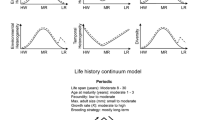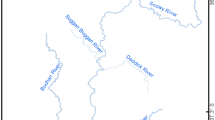Abstract
The southeastern United States has experienced severe, recurrent drought, rapid human population growth, and increasing agricultural irrigation during recent decades, resulting in greater demand for the water resources. During the same time period, freshwater mussels (Unioniformes) in the region have experienced substantial population declines. Consequently, there is growing interest in determining how mussel population declines are related to activities associated with water resource development. Determining the causes of mussel population declines requires, in part, an understanding of the factors influencing mussel population dynamics. We developed Pradel reverse-time, tag-recapture models to estimate survival, recruitment, and population growth rates for three federally endangered mussel species in the Apalachicola–Chattahoochee–Flint River Basin, Georgia. The models were parameterized using mussel tag-recapture data collected over five consecutive years from Sawhatchee Creek, located in southwestern Georgia. Model estimates indicated that mussel survival was strongly and negatively related to high flows during the summer, whereas recruitment was strongly and positively related to flows during the spring and summer. Using these models, we simulated mussel population dynamics under historic (1940–1969) and current (1980–2008) flow regimes and under increasing levels of water use to evaluate the relative effectiveness of alternative minimum flow regulations. The simulations indicated that the probability of simulated mussel population extinction was at least 8 times greater under current hydrologic regimes. In addition, simulations of mussel extinction under varying levels of water use indicated that the relative risk of extinction increased with increased water use across a range of minimum flow regulations. The simulation results also indicated that our estimates of the effects of water use on mussel extinction were influenced by the assumptions about the dynamics of the system, highlighting the need for further study of mussel population dynamics.






Similar content being viewed by others
References
Akaike H (1973) Information theory and an extension of the maximum likelihood principle. In: Petrov BN, Csaki F (eds) Second International Symposium on Information Theory. Akademiai Kiado, Budapest, Hungary, pp 267–281
Albertson PN, Torak LJ (2002) Simulated effects of ground-water pumpage on stream-aquifer flow in the vicinity of federally protected species of freshwater mussels in the Lower Apalachicola-Chattahootchee-Flint River Basin (Subarea 4), southeastern Alabama, northeastern Florida, and southwestern, Georgia. U.S. Geological Survey Water Investigations Report 02-4016
Annear T, Chisholm I, Beecher H, Locke A, Aarrestad P, Coomer C, Estes C, Hunt J, Jacobson R, Jobsis G, Kauffman J, Marshall J, Mayes K, Smith G, Stalnaker C, Wentworth R (2004) Instream flows for riverine resource stewardship. Instream Flow Council, Cheyenne, Wyoming
Brim Box J, Williams JD (2000) Unionid mollusks of the Apalachicola Basin in Alabama, Florida, and Georgia. Bulletin of the Alabama Natural History Survey 21:1–143
Burnham KP, Anderson DR (2002) Model selection and multimodel inference: a practical-theoretic approach, 2nd edn. Springer, New York
Gangloff MM, Feminella JW (2007) Stream channel geomorphology influences mussel abundance in southern Appalachian streams, U.S.A Freshwater Biology 52:64–74
Golladay SW, Gagnon P, Kearns M, Battle JM, Hicks DW (2004) Response of freshwater mussel assemblages (Bivalve:Unionidae) to record drought in the Gulf Coastal Plain of southwest Georgia. Journal of the North American Benthological Society 23:494–506
Haag WR, Warren ML Jr (2008) Effects of severe drought on freshwater mussel assemblages. Transactions of the American Fisheries Society 137:1165–1178
Hicks DW, Gill HE, Longsworth SA (1987) Hydrogeology, chemical quality, and availability of ground water in the Upper Floridan Aquifer, Albany area, GA. U.S. Geological Survey, Water-Resources Investigations Report 87-4145
Hook JE, Harrison KA, Hoogenboom G, Thomas DL (2005) Ag water pumping: final report of statewide irrigation monitoring. Georgia Geological Survey, Environmental Protection Division, Report No. 52. Atlanta, GA, 271 pp
Hosmer DW Jr, Lemeshow S (2000) Applied logistic regression. Wiley, New York
Hurvich CM, Tsai C (1989) Regression and time series model selection in small samples. Biometrika 76:297–307
Johnson PM (2001) Habitat associations and drought responses of mussels in the lower Flint River basin, southwest Georgia. M.S. Thesis. University of Georgia, Athens, GA, 114 pp
McCargo JW, Peterson JT (2010) An evaluation of the influence of seasonal base flow and geomorphic stream characteristics on Coastal Plain stream fish assemblages. Transactions of the American Fisheries Society 139:29–48
McKissick JC (2004) The economic importance of irrigated food and fiber production: a spotlight on Georgia’s Flint River Basin. The University of Georgia Center for Agribusiness and Economic Development, Athens
Mosner MS (2002) Stream-aquifer relations in the potentiometric surface of the Upper Floridan Aquifer in the Lower Apalachicola–Chattahoochee–Flint River Basin in parts of Florida, Georgia, and Alabama, 1999–2000. U.S. Geological Survey, Investigations Report 02-4244. http://pubs.usgs.gov/wri/wri02-4244. Accessed online 1 Aug 2010.
O’Brien CA, Brim Box J (1999) Reproductive biology and juvenile recruitment of the shinyrayed pocketbook, Lampsilis subangulata (Bivalvia: Unionidae) in Gulf Coastal Plain. American Midland Naturalist 142:129–140
O’Brien CA, Williams JD (2002) Reproductive biology of four freshwater mussels (Bivalvia: Unionidae) endemic to eastern Gulf Coastal Plain drainages of Alabama, Florida, and Georgia. American Malacological Bulletin 17:147–158
Opsahl S, Chapal SE, Hicks DW, Wheeler CK (2007) Evaluation of ground-water and surface-water exchanges using streamflow difference analyses. Journal of the American Water Resources Association 43:1132–1141
Pandolfo TJ, Cope WG, Arellano C, Bringolf RB, Barnhart MC, Hammer E (2010) Upper thermal tolerances of early life stages of freshwater mussels. Journal of the North American Benthological Society 29:959–969
Peterson JT, Jackson CR, Li G, McCargo J, McPherson R (2006) The development and evaluation of tools for evaluating flow requirements in streams in the Lower Flint River Basin, Georgia. Final Report to the Georgia Department of Natural Resources, Social Circle, GA, 367 pp
Peterson JT, Jackson CR, Shea CP, Li G (2009) Development and evaluation of a stream channel classification for estimating fish responses to changing streamflow. Transactions of the American Fisheries Society 138:1123–1137
Pierce RR, Barber NL, Stiles HR (1984) Georgia irrigation, 1970–1980: a decade of growth. U.S. Geological Survey, Water Resources Investigations Report 83-4177, Doraville, GA
Pradel R (1996) Utilization of capture-mark-recapture for the study of recruitment and population growth rate. Biometrics 52:703–709
Reinert TR, Wallin J, Griffin MC, Conroy MJ, van den Avyle MJ (1998) Long term retention and detection of oxytetracycline marks applied to hatchery-reared larval striped bass, Morone saxatilis. Canadian Journal of Fisheries and Aquatic Sciences 55:539–543
Richter BD, Braun DP, Mendelson MA, Master LL (1997) Threats to imperiled freshwater fauna. Conservation Biology 11:1081–1093
Rugel K, Jackson CR, Romeis JJ, Golladay SW, Hicks DW, Dowd JF (in press) Effects of irrigation withdrawals on streamflows in a karst environment: lower Flint River Basin, Georgia, USA. Hydrological Processes
SAS Institute (2001) SAS/STAT user’s guide, release 802. SAS Institute Inc, Cary
Skalski JR, Hoffmann A, Smith SG (1993) Testing the significance of individual- and cohort-level covariates in animal survival studies. In: Lebreton JD, North PM (eds) Marked individuals in the study of bird populations. Birkhäuser-Verlag, Basel, pp 9–28
Smale MA, Rabeni CF (1995) Hypoxia and hyperthermia tolerances of headwater stream fishes. Transactions of the American Fisheries Society 124:698–710
Sokal RR, Rohlf FJ (1995) Biometry: the principles and practice of statistics in biological research. Freeman, New York
Stamey TC (1996) Streamflow characteristics at selected sites in southwestern Georgia, southeastern Alabama, and northwestern Florida, near Lake Seminole. U.S. Geologic Survey Open File Report 95-455, Atlanta, GA, 11 pp
Strayer DL (1999) Use of flow refuges by unionid mussels in rivers. Journal of the North American Benthological Society 18:468–476
Strayer DL (2008) Freshwater mussel ecology: a multifactor approach to distribution and abundance. University of California Press, Berkeley
Torak LJ, Painter JA (2006) Geohydrology of the lower Apalachicola–Chattahoochee–Flint River basin, southwestern Georgia, northwestern Florida, and southeastern Alabama. U.S. Geological Survey, Report Number 2006-5070, Atlanta, GA, 80 pp
US Geological Survey (USGS) (2010a) USGS surface-water data for Georgia. http://waterdata.usgs.gov/ga/nwis/sw/. Accessed online 1 Aug 2010
US Geological Survey (USGS) (2010b) Georgia low-flow frequency information. http://ga2.er.usgs.gov/lowflow/. Accessed online 1 Aug 2010
Villella RF, Smith DG, Lemarié (2004) Estimating survival and recruitment in a freshwater mussel population using mark-recapture techniques. American Midland Naturalist 151:114–133
White GC, Burnham KP (1999) Program MARK: survival estimation from populations of marked animals. Bird Study 46(Supplement):120–138
Williams BK, Nichols JD, Conroy MJ (2002) Analysis and management of animal populations. Academic Press, San Diego
Williams JD, Bogan AE, Garner JT (2008) Freshwater mussels of Alabama and the Mobile Basin in Georgia, Mississippi, and Tennessee. University of Alabama Press, Tuscaloosa
Acknowledgments
This project was funded by a grant from the United States Fish and Wildlife Service and the Georgia Department of Natural Resources. A number of people were instrumental in providing assistance with this project. We are particularly indebted to the many individuals who aided during field sampling, including Karen Herrington, Sandy Pursifull, Beau Dudley, Paul Benton, Andrea Crownhart, Justin Dycus, Jason Emmel, Ryan Harrell, Katie Owers, Will Pruitt, Amos Tuck, Mieko Camp, and Deb Weiler. Special thanks go out to Sandy Abbott and Carson Stringfellow for initiating the tagging study and providing many useful hands during sampling. The manuscript was improved with suggestions from T. Kwak, B. Albanese, M. Gangloff and anonymous reviewers. The use of trade, product, industry or firm names or products is for informative purposes only and does not constitute an endorsement by the U.S. Government or the U.S. Geological Survey. The Georgia Cooperative Fish and Wildlife Research Unit is jointly sponsored by the U.S. Geological Survey, the U.S. Fish and Wildlife Service, the Georgia Department of Natural Resources, the University of Georgia, and the Wildlife Management Institute.
Author information
Authors and Affiliations
Corresponding author
Rights and permissions
About this article
Cite this article
Peterson, J.T., Wisniewski, J.M., Shea, C.P. et al. Estimation of Mussel Population Response to Hydrologic Alteration in a Southeastern U.S. Stream. Environmental Management 48, 109–122 (2011). https://doi.org/10.1007/s00267-011-9688-2
Received:
Accepted:
Published:
Issue Date:
DOI: https://doi.org/10.1007/s00267-011-9688-2




